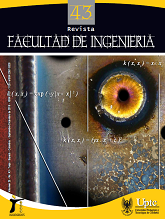Efecto de la infiltración de lluvia en la respuesta hidráulica y en los mecanismos de falla de modelos de taludes arenosos

Resumen
Presenta los resultados experimentales obtenidos en modelos de taludes arenosos sometidos a lluvia. Se construyeron cuatro modelos para evaluar el efecto del contenido inicial de agua y de la intensidad de la lluvia en el comportamiento hidráulico y el mecanismo de falla en los taludes. Estos modelos fueron instrumentados con sensores de contenido volumétrico de agua, para monitorear el avance del frente húmedo y con inclinómetros para medir los movimientos laterales de talud. Los modelos fueron sometidos a intensidades de lluvia y duraciones que se encontraron entre 25 y 50 mm/h y 19 y 152 minutos, respectivamente. Adicionalmente, se discutió el efecto de un evento de lluvia de baja intensidad previo a una lluvia de alta intensidad. De los resultados, se observa que el tiempo requerido para alcanzar la falla del talud está influenciado por el contenido inicial de agua, siendo más corto el tiempo para contenidos de agua iniciales más altos. Los resultados presentados son útiles para entender el comportamiento de los taludes naturales y terraplenes parcialmente saturados y expuestos a infiltración de lluvias, así como para complementar la base de datos existente en este tema.Palabras clave
contenido inicial de agua, ensayos de laboratorio, infiltración de agua, modelos de talud, suelo parcialmente saturado
Citas
- L. W. Abramson, T. S. Lee, S. Sharma, and G. M. Boyce. Slope Stability and Stabilization Methods. New York: Wiley Interscience Publications, 2001.
- S. A. Anderson and N. Sitar, “Analysis of rainfall-induced debris flows,” J Geotech Engrg, vol. 121(7), pp. 544-552, Jul. 1995. DOI: http://dx.doi.org/10.1061/(ASCE)0733-9410(1995)121:7(544). DOI: https://doi.org/10.1061/(ASCE)0733-9410(1995)121:7(544)
- R. P. Orense. Geotechnical Hazards: Nature, Assessment and Mitigation. Quezon City: The University of the Philippines Press, 2003.
- M. R. Hakro and I. S. H. Harahap, “Laboratory experiments on rainfall-induced flowslide from pore pressure and moisture content measurements,” Natural Hazards and Earth System Sciences, vol. 3, pp. 1575-1613, 2015. DOI: http://dx.doi.org/10.5194/nhessd-3-1575-2015. DOI: https://doi.org/10.5194/nhessd-3-1575-2015
- Y. Yoshida, J. Kuwano, and R. Kuwano, “Rain-induced slope failures caused by reduction in soil strength,” Soils and Foundations, vol. 31(4), pp. 187-193, 1991. DOI: http://dx.doi.org/10.3208/sandf1972.31.4_187. DOI: https://doi.org/10.3208/sandf1972.31.4_187
- H. Yamagishi, T. Horimatsu, T. Kanno, and M. Hatamoto, “Recent landslides in Niigata Region, Japan,” in Proc. of the 4th Asian Symposium on Engineering Geology and the Environment, Hong Kong, 2004, pp. 1- 6. DOI: https://doi.org/10.1007/s10346-004-0032-2
- Y. Nakata, D. Liu, M. Hyodo, N. Yoshimoto, and Y. Kato, “Numerical simulation of an expressway embankment slope failure,” in Proc. of Theoretical and Numerical Advances in Unsaturated Soil Mechanics, 2010, pp. 719-724.
- H. Chen, S. Dadson, and Y. Chi, “Recent rainfall induced landslides and debris flow in northern Taiwan,” Geomorphology, vol. 77(1-2), pp. 112-125, Jul. 2006. DOI: http://dx.doi.org/10.1016/j.geomorph.2006.01.002. DOI: https://doi.org/10.1016/j.geomorph.2006.01.002
- S. W. C. Au, “Rain-induced slope instability in Hong Kong,” Engineering Geology, vol. 51 (1), pp. 1-36, Nov. 1998. DOI: http://dx.doi.org/10.1016/S0013-7952(98)00038-6. DOI: https://doi.org/10.1016/S0013-7952(98)00038-6
- E. W. Brand, “Some thoughts on rain-induced slope failures,” in Proc. of the 10th International Conference on Soil Mechanics and Foundation Engineering, vol. 3, 1981, pp. 373-376.
- E. W. Brand, “Analysis and design in residual soils,” In Engineering and Construction in Tropical and Residual Soils, Proceedings of the ASCE Geotechnical Division Specialty Conference, Honolulu, Hawaii, 1982, pp. 89-143.
- R. P. Brenner, H. K. Tam, and E. W. Brand, “Field stress path simulation of rain-induced slope failure,” in Proceedings of the 11th International Conference on Soil Mechanics and Foundation Engineering, vol. 2, 1985, pp. 991-996.
- J. H. Atkinson and D. M. Farrar, “Stress path tests to measure soil strength parameters for shallow landslips,” in Proceedings of the 11th International Conference on Soil Mechanics and Foundation Engineering, A. A. Balkema, Brookfield, Vt., vol. 2, 1985, pp. 983-986.
- K. Farooq, “Experimental Study on Failure Initiation in Sandy Slopes due to Rainfall Infiltration”. Ph. D. dissertation, University of Tokyo, Japan. 2002.
- G. P. K. Chaminda, “Real Time Prediction of Rain-Induced Embankment by Minimum Measurements with Back-analysis for SWCC Parameters”. Ph. D. Dissertation, University of Tokyo, Japan, 2006.
- K. A. Johnson and N. Sitar, “Hydrologic Conditions leading to debris-flow initiation,” Canadian Geotechnical Journal, vol. 27(6), pp. 789-801, Dec. 1990. DOI: http://dx.doi.org/10.1139/t90-092. DOI: https://doi.org/10.1139/t90-092
- R. H. Campbell, “Soil slips, debris flows and rainstorms in the Santa Monica Mountains and vicinity,” Southern California. U.S. Geological Survey Professional Paper 851, 1975, 51 pp. DOI: https://doi.org/10.3133/pp851
- P. Boonsinsuk and R. N. Yong, “Analysis of Hong Kong residual soil slopes,” Engineering and Construction in Tropical and Residual Soils, Proc. ASCE Geotechnical Division Specialty Conference, Honolulu, Hawaii, 1982, pp. 463-482.
- J. D. Eckersley, “Instrumented laboratory flowslides,” Géotechnique, vol. 40(3), pp. 489-502, Sep. 1990. DOI: http://dx.doi.org/10.1680/geot.1990.40.3.489. DOI: https://doi.org/10.1680/geot.1990.40.3.489
- S. Shimoma, R. P. Orense, T. Honda, K. Maeda, and I. Towhata, “Model tests on slope failures caused by heavy rainfall,” in Proc. Interpraevent 2002 in the Pacifica Rim: Protection of Habitat against Floods, Debris Flows and Avalanches, vol. 2, 2002, pp., 547-557.
- M. Hormaza, “Investigación preliminar de las causas probables de deslizamientos en las laderas de Medellín”. Undergraduate dissertation, Universidad Nacional de Colombia, 529 pp., 1991.
- R. Saldarriaga, “Inventario y sistematización de los desastres naturales reportados en los municipios del Valle de Aburrá, entre los años 1900 y 2002”. Undergraduate Dissertation, Universidad EAFIT, 120 pp., 2003.
- E. Aristizábal and J. Gómez, “Inventario de emergencias y desastres en el Valle de Aburrá: originados por fenómenos naturales y antrópicos en el periodo 1880-2007,” Revista Gestión y Ambiente, vol. 10(2), pp. 17-30, 2007.
- H. Rahardjo, X. W. Li, D. G. Toll, and E. C. Leong, “The effect of antecedent rainfall on slope stability,” Geotechnical and Geological Engineering, Springer, vol. 19, pp. 371-399, 2001. DOI: http://dx.doi.org/10.1023/A:1013129725263. DOI: https://doi.org/10.1007/978-94-015-9775-3_8
Descargas
Los datos de descargas todavía no están disponibles.